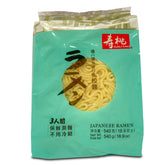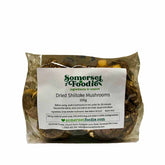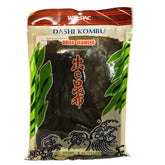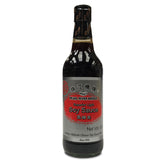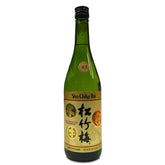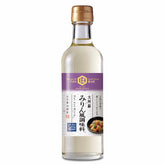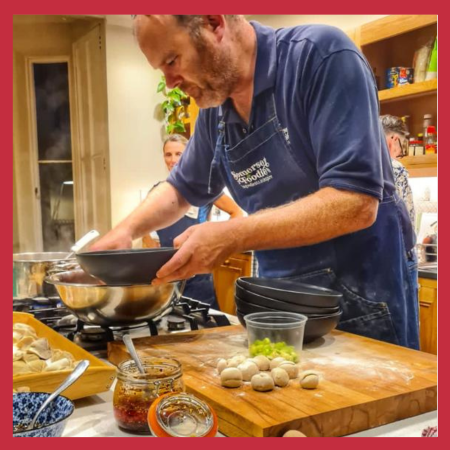Shoyu Pork Ramen
My previous ramen recipe was for a quick-fire version that allowed you to make ramen in an evening. This is a classic version that requires planning and patience - extracting the most flavour from the ingredients does take time. I don't think there is any more work involved than making a cake - sponge, icing, decoration etc, it's just that the whole ramen process is drawn out and there are quite a few unfamiliar ingredients. I love the anticipation of a spectacular meal and this ramen dish feels like a foodie triumph when you bring it to the table.
In a Japanese ramen bar, the menu is divided into three main categories. This recipe is for a 'Shoyu' (soy) ramen - because soy is used to season the broth. The two other types are Miso ramen, which uses miso as the seasoning and Shio ramen that uses salt. Shoyu ramen is the most popular in Japan and there are loads of variations.
Shoyu ramen incorporates two liquid elements which are combined with the noodles and toppings right at the end of the ramen process. The first is a meaty broth for the base. In this particular recipe it's called 'Tonkotsu' - which means 'pork bone' and that's where the whole process starts.
The second liquid element is a seasoning known as a 'Tare' (pronounced 'tah-reh'). To make Tare you combine dashi stock with soy sauce, sake, mirin, a little rice vinegar and a little brown sugar. If you can get the hang of making your own dashi stock for the Tare you won't look back - dashi stock is not only great in making ramen, it's also a lovely base for soups and stews.
What I love about making ramen is that there is no right or wrong. Sure there are a few techniques that will help to give you a better end result, but don't be frightened to experiment with different ingredients and flavours. You might need to invest in a few things for your Japanese store-cupboard at home, but these ingredients will all keep really well for your next Japanese foodie adventure.
Ingredients for Shoyu Pork Ramen
For the Broth
3kg Pork Bones (ask a good butcher)
500g Chicken Wings
6.5 ltrs Cold Water
100g Fresh Ginger, skin on and sliced roughly
3 White Onions, peeled and roughly chopped
2 Whole Bulbs of Garlic, sliced through the equator
30g Dried Shiitake Mushrooms
2 Star Anise
For the Tare (seasoning)
10g Kombu Seaweed
10g Dried Shiitake Mushrooms
5g Katsuobushi
400ml Cold Water
200ml Light Soy Sauce
100ml Sake
100ml Mirin
1tsp Soft brown Sugar
1tsp Rice Wine Vinegar
For the Noodles & Toppings
1 x Pack Sau Tao Ramen Noodles
500g Pork Belly Slices, skin trimmed off
3 Eggs, hard boiled for 6½ minutes, cooled and peeled
200g Bean Sprouts, blanched for 30 seconds to remove the 'rawness'
150g Kale, stalks removed and steamed for 3-4 minutes
1 x Bunch Spring Onions
6 Red Radishes, thinly sliced
1tbsp Toasted White Sesame Seeds
A few drops of La-Yu Chilli Oil
A dusting of Shichimi Togarashi (Japanese Seven Spice)
4 x Large warm bowls serve each portion of ramen
Time Required: Two Days
Prep: Heavy
Washing up: Multiple pans
Allergens: SOY, SESAME, GLUTEN
DAY ONE
1. In the biggest saucepan you have, cover the pork bones with cold water and leave for 1 to 2 hours. This will remove the blood from the bones that will cloud your broth and impair the flavour. After this time, you will notice that the water has turned red in colour. You can leave the bones in the water longer, but I find that a couple of hours is fine.
2. Pour this water away and rinse the bones under the tap.
3. Put the pork bones back into the pot, along with the raw chicken wings, sliced ginger, garlic bulbs and dried shiitake mushrooms and add in 6.5 litres of cold water.
4. Bring to a simmer and cook, with the lid off, for 8 hours - longer if you have time. For the first hour or so, you will have to skim off any scum that comes to the surface. You may find that you have to top up the water a little in the first 2-3 hours, but for the final few hours, let the water level reduce to concentrate the flavour.
5. Whilst your meat broth is cooking you can start making the dashi stock. Wipe the kombu seaweed clean with a damp cloth, and rinse the dried shiitake - place these two ingredients in a saucepan with the cold water. The key is not to boil the seaweed, so place the pan over a really low heat and slowly bring to a simmer. As soon as there are signs that the water is beginning to bubble, remove from the heat. Add in the katsuobushi flakes and leave for 30 minutes to infuse. Strain through a fine sieve and keep in the fridge.
5. Once you've finished cooking the meat broth, strain through a sieve. There will be some fat from the pork bones and chicken wings that rises to the surface of your finished broth, this is a good thing and will make your finished ramen dish taste even better.
6. Keep your meat broth in the fridge over night, it will keep well for 2-3 days.
DAY TWO - RAMEN DAY
1. Remove the meat broth from the fridge and warm up in a deep pan. Add in the pork belly slices and poach in the broth for about an hour and half, you want the pork to be nice and tender.
2. To make the Tare seasoning, remove the dashi from the fridge and in a saucepan, add in the soy sauce, mirin, sake, sugar and vinegar. Bring to a gentle simmer and cook until the liquid reduces by about a half. This should take about 30 minutes.
3. Slice the spring onions and radishes.
4. Hard boil the eggs for 6½ minutes, remove them from the pan and cool under running water before peeling and slicing in half. I then use this water to blanch the bean sprouts and steam the kale. A metal steaming pan is really useful to do all these jobs in one pan.
5. Bring a large saucepan to the boil, ready to cook the noodles.
6. Once the pork is tender remove from the broth and cut into manageable pieces for each ramen bowl. Drizzle a little of the Tare over the meat and keep warm to one side. Keep the broth hot, ready to serve.
7. Now cook the noodles, they need just two minutes in boiling water.
8. It's now time to construct the ramen bowls. Start by adding a couple of tablespoons of the Tare into each bowl, you can adjust the amount of Tare you serve depending on how salty you like your ramen. Ladle in the hot meat broth and add in the noodles. Arrange all the toppings in the bowl, drizzle in some La-Yu oil, add a light dusting of Shichimi Togarashi and a few sesame seeds.
9. Make sure everyone has plenty of napkins to wipe their chins and tuck in to your masterpiece. I like to have any spare Tare on the table in case anybody prefers extra seasoning plus a little extra La-Yu for extra kick.
Enjoy - and foodies PLEASE share your ramen with us on social media - or leave a recipe review here if you do make this at home.

